Date : February 23 - 24, 2010
【Press Tour】February 23-24, 2010:Toyama, Advanced City in Eco-Vehicle
post date : 2013.08.22
Toyama Press Tour 2009: Harmonize the city with environment ~Toyama: Advanced City in Eco-Vehicle~
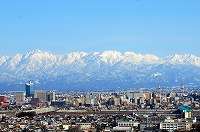
The Environmental Model City Plan of Action was formulated in Toyama City which had proposed to be a citizen- and environmentally-friendly “Compact City”. The city is now transforming itself to a “low carbon society”.
In order to achieve that goal, the city focuses on the revitalization of public transportation, greater use of eco-friendly vehicles and bicycles, and introducing and spreading new energy.The participating journalists will have an opportunity to learn how the Plan of Action has been implemented, what kind of result has been emerging, and what are the prospects and challenges in the future.
***************************
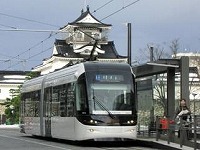 The Environmental Model City Plan of Action was formulated in Toyama City which had proposed to be a citizen- and environmentally-friendly “Compact City”. The city is now transforming itself to a “low carbon society”, and aims to reduce its CO2 emissions by 30 percent (from the 2005 level) by 2030.
The Environmental Model City Plan of Action was formulated in Toyama City which had proposed to be a citizen- and environmentally-friendly “Compact City”. The city is now transforming itself to a “low carbon society”, and aims to reduce its CO2 emissions by 30 percent (from the 2005 level) by 2030.
In order to achieve that goal, the city focuses on the revitalization of public transportation, greater use of eco-friendly vehicles and bicycles, and introducing and spreading new energy. The loop route for trams was opened on 23 December, 2009, for the first time in 37 years. Bicycle stations will be set up mainly near tram stations in March, and those who have registered will be able to rent bicycles for free. In addition, the city actively promotes the manufacturing of bio mass and bio diesel fuels made from waste oil.
The participating journalists will have an opportunity to learn how the Plan of Action has been implemented, what kind of result has been emerging, and what are the prospects and challenges in the future.
※This press tour has been co-organized by Toyama City, Toyama Television Broadcasting Co., Ltd., and Foreign Press Center, Japan.
<Presentations>
1. Centram Toyama, Eco-Friendly Tram: a Revived Loop Route after 37 years
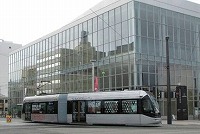 The Loop Route, nicknamed “Centram”, started to operate on 23 December, 2009. Toyama City is promoting the development of a compact city by revitalizing public transportation and the city center. The loop route is the pivot of such attempts.
The Loop Route, nicknamed “Centram”, started to operate on 23 December, 2009. Toyama City is promoting the development of a compact city by revitalizing public transportation and the city center. The loop route is the pivot of such attempts.
The city newly constructed approx. 900 meter of the route in the central area, and connected it with the existing routes. This connected Toyama station with the Central City. The loop route was revived for the first time in thirty-seven years. It takes 20 minutes for the tram to go round the Central City (3.4 kilometers). Centram Toyama is the next generation light rail transit with two cars. It is a newly-designed ultra low-floor tram with colors of white, black and silver, and responds to the needs for barrier-free services. With the construction of the new route, the scenery along the route was also newly designed. Big shopping malls became like transit malls in Europe, introducing stone-paved streets.
It has been two months since Centram Toyama started operation, and people are using it more than the city initially expected. This tour will give you an opportunity to ride on the tram and also collect information from city officials on this eco-vehicle and the unique city planning.
2. Bike-Sharing Project, the First Attempt in Japan – Will Toyama City look like Paris?
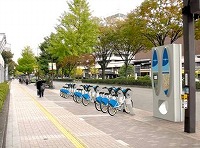 In March 2010, Toyama City will launch a new system under which Toyama citizens share the use of bicycles. Users register themselves with this system first, then can rent bicycles at any of the stations set up in the city, and return them to any station they like. This system is calledlarge-scale rental cycle or community cycle, and draws attention as eco-friendly public transportation by bicycle.
In March 2010, Toyama City will launch a new system under which Toyama citizens share the use of bicycles. Users register themselves with this system first, then can rent bicycles at any of the stations set up in the city, and return them to any station they like. This system is calledlarge-scale rental cycle or community cycle, and draws attention as eco-friendly public transportation by bicycle.
This system has become common especially in Europe, including the Velib system in France, but in Japan, Toyama City is the first to fully introduce this system. The City built fifteen stationsin the city center, especially in the vicinity of tram stations, and prepared 150 bicycles. Together with Toyama Light Rail and Centram, this project will form the center of Toyama’s environmentally-friendly life, avoiding dependence on cars as transportation means.
A city official will give you a briefing about this project, and you will have a test-ride at Toyama City Hall mae station and Toyama City Hall Square with supporters of this project.
3. Hokuriku Electric Power Company - Buses Using Lithium Ion Batteries Have Started Operation in this Advanced Prefecture
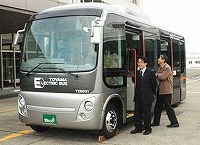 For about one month from the middle of February Hokuriku Electric Power Company will conduct a test-operation of buses which use lithium ion batteries, with Toyama City which strives to reduce CO2 emissions. It is the first time in Japan for a low-floor electric bus, which is friendly to elderly people, to operate on a bus route.
For about one month from the middle of February Hokuriku Electric Power Company will conduct a test-operation of buses which use lithium ion batteries, with Toyama City which strives to reduce CO2 emissions. It is the first time in Japan for a low-floor electric bus, which is friendly to elderly people, to operate on a bus route.
Hokuriku Electric Power Company started research on this low-floor electric bus from April 2009 asa “model project to verify the creation of a low-carbon society” promoted by the Ministry of Economy, Trade and Industry, and co-developed the bus with Jbus (Ishikawa Prefecture), Tokyo R&D Co., Ltd (Tokyo), and Toyama Local Railway Co., Ltd.
The entire length of the bus is 7 meters, the width 2 meters, and the height 3 meters, and it can carry 29 people in total. It has lithium ion batteries and can run 68 kilometers on a full charge. In the test-operation, the bus will run the central route, same route as Toyama’s community bus ‘Maidohaya’. The bus will be able to reduce CO2 emissions by half or one third, compared with the Maidohaya which runs on diesel fuel.
This eco-friendly bus will come to Toyama Airport and take you to the city. It will be your main transportation means for Day 1. A city official will brief you on the purpose and characteristics of this bus while you experience the quality of the ride.
4. Takeoka Mini Car Co., Ltd.- Manufacturer of Electric Mini Car
Go to Takeoka Mini Car's website (Japanese only)
 Takeoka Mini Car Co., Ltd. develops and sells electric scooters and mini cars for elderly people. Orders come from all over Japan as daily transportation means for the elderly who are concerned about driving cars. These electric cars are compact, with low levels of maximum speed and acceleration, so they are safe and comfortable for old people with slow responses to use.
Takeoka Mini Car Co., Ltd. develops and sells electric scooters and mini cars for elderly people. Orders come from all over Japan as daily transportation means for the elderly who are concerned about driving cars. These electric cars are compact, with low levels of maximum speed and acceleration, so they are safe and comfortable for old people with slow responses to use.
There is another type of electric mini car which allows people in wheelchairs to enter from the rear and drive without leaving the wheelchair. The company says “As you become older, it may be difficult to drive a large car. Enjoy your car life with mini cars”.
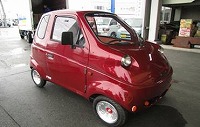
This press tour will give you an opportunity mainly to collect information on “Miryu”, a new model which will go on sale this May. Miryu was co-designed with the Faculty of Art and Design, Toyama University, and the interior comfort was also improved. In addition, a space for a pet is also provided next to the driver’s seat because many elderly people have pets. You can have a test-ride in this vehicle and make a comparison with the existing mini cars.
5. Jyonan Co., Ltd – Small Auto Factory at the foot of the mountain improved China's electric scooters and started to sell them at home and abroad
Go to Jyonan's website (Japanese only)
 Jyonan Co. Ltd improved the electric scooters commonly used by Chinese people into ones which run safely and conformably in Japan, and sells them. They are getting popular in Japan. The price is about 200,000 yen, and each scooter has 35 kilograms of lead batteriesunder its seat. It can be charged from a 100-volt socket of the kind widely used in Japanese houses, and can run approx. 60 kilometers on six to eight hours of charge. The cost of electricity in this case is only about 30 yen, more economical than gasoline-driven cars.
Jyonan Co. Ltd improved the electric scooters commonly used by Chinese people into ones which run safely and conformably in Japan, and sells them. They are getting popular in Japan. The price is about 200,000 yen, and each scooter has 35 kilograms of lead batteriesunder its seat. It can be charged from a 100-volt socket of the kind widely used in Japanese houses, and can run approx. 60 kilometers on six to eight hours of charge. The cost of electricity in this case is only about 30 yen, more economical than gasoline-driven cars.
From the reliability point of view, the current model has a shortcoming in the amount of lead the vehicle needs. However, the company continues to improve the vehicle and wants to sell it not only in Toyama Prefecture but also through recruiting sales agencies in the Tokyo metropolitan area where many people use scooters.You will have an opportunity to ride on the scooter and listen to stories about the company’s business and future prospects, from the president.
6. Toyama City Eco Town
Go to Toyama City Eco Town's website (Japanese only)
(1)Toyama BDF (Bio Diesel Fuel) Co., Ltd.: Facility to Recycle Waste Oil
Go to Toyama BDF's website (Japanese only)
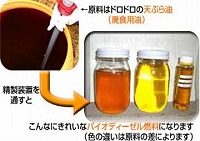 Toyama BDF Co., Ltd. produces bio diesel fuel (BDF) from waste oil coming from school lunch centers, food-making factories, restaurants, supermarkets and hotels.
Toyama BDF Co., Ltd. produces bio diesel fuel (BDF) from waste oil coming from school lunch centers, food-making factories, restaurants, supermarkets and hotels.
Edible oil is used as an alternative fuel to light oil in some countries, but in Japan where edible oil is imported, costwise, it makes better sense to refine waste oil to produce BDF. The BDF produced is used as an alternative fuel to light oil by the city’s garbage collection trucks, buses and working vehicles of private companies.(Photo right: BDF produced from waste oil)
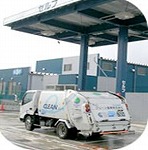
The filling stations are located on the premises of Toyama BDF Co., Ltd. and the Toyama Environment Center.
You will travel from your hotel to Eco Town in a bus using BDF. The company will show you the verification experiment using new original technology which just started this year.
(2) Eco Mind Co., Ltd.: Manufacturer of Solid Fuel Using Paper and Wood Wastes
Go to Eco Mind's website (Japanese only)
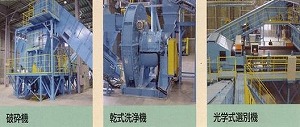 This company produces recycled plastic fuel (RPF) from wastes which were formerly incinerated or buried because they were hard to recycle, and sells RPF to Toyama’s paper manufacturing companies and factories. This is how it tries to create a cycle of waste in the region. (Photo right: Refractory waste combustion system)
This company produces recycled plastic fuel (RPF) from wastes which were formerly incinerated or buried because they were hard to recycle, and sells RPF to Toyama’s paper manufacturing companies and factories. This is how it tries to create a cycle of waste in the region. (Photo right: Refractory waste combustion system)
Thanks to the development and improvement of the equipments, and effectively combining them, an alternative to fossil fuels is produced from such wastes as fiber paper, wood, plastic, and mixed inflammable materials which are tainted or dirty. In this way, the company promotes resources circulation and helps prevent global warming.
In the winter of 2009, the company started to recycle waste synthetic rubber such as tires, which used to be difficult to treat, to make rubber chips for fuel. The company contributes to reducing wastes and preventing global warming by making a cycle of various fuels, reducing the environmental burden from incineration, and promoting the use of non-fossil fuels.
7. White Illumination Toyama with 98,000 LED bulbs: Expression of Eco-Friendly Minds of Toyama Citizens
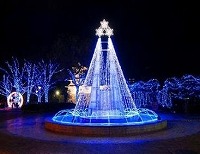 The main street in Toyama City is beautifully illuminated during winter time. Financial contributions by its citizens make every single bulb shine, so these lights are an expression of the citizens’ solidarity. This year witnessed 98,000 bulbs.
The main street in Toyama City is beautifully illuminated during winter time. Financial contributions by its citizens make every single bulb shine, so these lights are an expression of the citizens’ solidarity. This year witnessed 98,000 bulbs.
All the light sources were changed to LED in Toyama City which focuses on living harmoniously with the environment. LED bulbs have overwhelming longevity and energy saving capacity, and their environmental burden on the lifecycle (CO2 conversion) is less than 30 percent than that of conventional lighting. You will see how the citizens of Toyama, who want to make the severe winter as warm as possible, decorate their city in an eco-friendly manner.
8. Research Center for the Graduate School of Science and Technology, Toyama University: Research on Plant Cultivation in Space Station
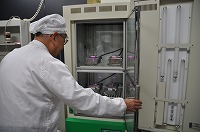 The research experiment conducted by the Graduate School of Science and Technology, Toyama University, revealed that plants could grow faster in space than on earth. Plants were cultivated both in “Kibo”, the International Space Station, and in a research laboratory on earth. It turned out that their stems grew faster and the aging of leaves was slower in space. The University wants to conduct further research into the effects of gravity on plants, and create an environment in which human beings can stay longer in space in the future.(Photo right: Space Seed Experiment)
The research experiment conducted by the Graduate School of Science and Technology, Toyama University, revealed that plants could grow faster in space than on earth. Plants were cultivated both in “Kibo”, the International Space Station, and in a research laboratory on earth. It turned out that their stems grew faster and the aging of leaves was slower in space. The University wants to conduct further research into the effects of gravity on plants, and create an environment in which human beings can stay longer in space in the future.(Photo right: Space Seed Experiment)
9. Ikedaya Yasubei Shoten: Store which uses herbal medicines for meals, believing that “we are what we eat” (Ishoku-Dogen in Japanese)
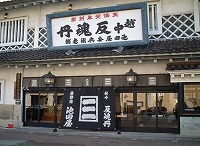 Studies on health have been conducted from various angles in Toyama City, which is famous as a “medicine city”. Ikedaya Yasubei Shoten has the motto “you are what you eat”, and provides health-oriented cuisine.
Studies on health have been conducted from various angles in Toyama City, which is famous as a “medicine city”. Ikedaya Yasubei Shoten has the motto “you are what you eat”, and provides health-oriented cuisine.
Located in the city center, it still keeps the appearance of a drug store of the Edo period, and sellstraditional medicines, mainly Kanpo (Chinese) medicines. The second floor is a restaurant which offers healthy menus, including herbal medicine dishes which use an ancient kind of rice and Asian ginseng, herbal tea, and herbal tea and ice cream. (This is where we have lunch on the first day.)
<Tour Itinerary and Application Details>
1. Itinerary (tentative): February 23 (Tuesday)-24(Wednesday)
[Day 1]
08:15 Meet at Tokyo Haneda Airport
09:05 Leave by ANA Flight 883
10:05 Arrive at Toyama Airport
10:30 Leave the Airport by chartered bus which uses lithium ion batteries
- Briefing about the eco-friendly bus
11:55 Get on “Centram Toyama” at Toyama Kokusai Kaigijyo-mae and go round the loop route
12:30-13:30 Lunch at Ikedaya Yasubei Shoten
13:45-14:45 Visit the bike-sharing project site and test-ride bicycles in the station in front of Toyama City Hall
15:00-16:00 Visit the Research Center for the Graduate School of Science and Technology, Toyama University (Research on plant cultivation in space)
16:30 Check in at ANA Crown Plaza Hotel
16:30-17:30 Rest (Visit to the white illumination site which uses 98,000 LED bulbs at five p.m., if you wish)
17:30-18:30 Presentations by City Mayor Masashi Mori and Mr. Shigenobu Nakamura, Head, Environmental Affairs Department, Toyama City, on the Environmental Model City Plan of Action
18:30-19:30 Reception hosted by Toyama City
(Stay overnight at ANA Crown Plaza Hotel)
[Day 2]
09:30 Leave hotel
10:00 Arrive at Toyama City Eco Town
- Visit Toyama BDF CO., Ltd. (travel by chartered bus using bio fuels, made by Toyama BDF Co., Ltd., to Eco Mind Co., Ltd.)
- Visit Eco Mind Co., Ltd.
12:00-12:30 Get on Toyama Light Rail to Toyama Station, and go up to the top floor of the Ekimae Urban Place Building
12:30-13:30 Lunch at Kaiseki Matsuya
14:15-15:30 Visit Jyonan Trading Company and test-ride electric scooters
15:45-17:10 Visit Takeoka Mini Car Co., Ltd. and test-ride electric mini cars
17:30 Arrive at Toyama Airport
18:10 Leave by ANA Flight 890
19:20 Arrive at Tokyo Haneda Airport
2. Qualification: Bearer of Gaimusho Press Registration Card
3. Expenses: 13,000 yen per person including transportation, meals and accommodation.
*FPC will inform the participants of payment methods, cancellation fee etc. later on.
4. Participants: Limited to the first 10 applicants on a first-come first-served basis. (Only one reporter and one photographer from each company, but two participants from each TV team will be acceptable.)
5. FPCJ Contact: Ms. Koizumi and Ms. Yamauchi (TEL: 03-3501-3405)
6. Remarks:
(1)There are some restrictions on photographing and filming at the tour sites. Please follow the instructions of the officials on duty.
(2)Toyama City, Toyama Television Broadcasting Co., Ltd. and FPCJ will not be liable for any inconvenience, trouble or accident that might occur in the course of the tour.



